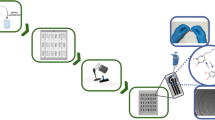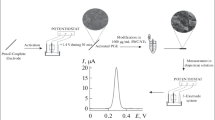Abstract
An unconventional, flexible, disposable paper-based selective sensing platform for dopamine in the presence of ascorbic acid, suitable for wearable electronics, has been described for the first time in this work. The carbon nanotube ink-modified paper (CNIMP) in the presence of an anionic surfactant was able to discriminate effectively between dopamine and ascorbic acid thereby alleviating the difficulties associated with the sensing of dopamine in the presence of high concentration of ascorbic acid which undergoes oxidation at similar potential. The CNIMP electrode provided a large surface area in addition to its flexibility and disposability which was 25 times higher compared to a glassy carbon electrode of the same geometric area. The conductivity of the CNIMP electrodes as measured by four probe conductivity measurements was reasonably high of the order of 1.7 × 10−2 S cm−1 facilitating its usefulness for the development of flexible sensors. The microscopic features of the electrodes showed the dense coverage and even distribution of carbon nanotubes on the surface with the surfactant molecules uniformly encapsulated on the surface.








Similar content being viewed by others
References
Comer JP (1956) Semiquantitative specific test paper for glucose in urine. Anal Chem 28(11):1748–1750
Liana DD, Raguse B, Gooding JJ, Chow E (2012) Recent advances in paper-based sensors. Sensors 12(9):11505–11526
Fenton EM, Mascarenas MR, López GP, Sibbett SS (2008) Multiplex lateral-flow test strips fabricated by two-dimensional shaping. ACS Appl Mater Interfaces 1(1):124–129
Noiphung J, Songjaroen T, Dungchai W, Henry CS, Chailapakul O, Laiwattanapaisal W (2013) Electrochemical detection of glucose from whole blood using paper-based microfluidic devices. Anal ChimActa 788:39–45
Tan SN, Ge L, Tan HY, Loke WK, Gao J, Wang W (2012) Paper-based enzyme immobilization for flow injection electrochemical biosensor integrated with reagent-loaded cartridge toward portable modular device. Anal Chem 84(22):10071–10076
Schilling KM, Lepore AL, Kurian JA, Martinez AW (2012) Fully enclosed microfluidic paper-based analytical devices. Anal Chem 84(3):1579–1585
Lankelma J, Nie Z, Carrilho E, Whitesides GM (2012) Paper-based analytical device for electrochemical flow-injection analysis of glucose in urine. Anal Chem 84(9):4147–4152
Dungchai W, Chailapakul O, Henry CS (2009) Electrochemical detection for paper-based microfluidics. Anal Chem 81(14):5821–5826
Kuwahara T, Ohta H, Kondo M, Shimomura M (2008) Immobilization of glucose oxidase on carbon paper electrodes modified with conducting polymer and its application to a glucose fuel cell. Bioelectrochemistry 74(1):66–72
Shiroma LY, Santhiago M, Gobbi AL, Kubota LT (2012) Separation and electrochemical detection of paracetamol and 4-aminophenol in a paper-based microfluidic device. Anal ChimActa 725:44–50
Delaney JL, Hogan CF, Tian J, Shen W (2011) ElectrogeneratedChemiluminescence detection in paper-based microfluidic sensors. Anal Chem 83(4):1300–1306
Wang P, Ge L, Ge S, Yu J, Yan M, Huang J (2013) A paper-based photoelectrochemical immunoassay for low-cost and multiplexed point-of-care testing. ChemCommun 49(32):3294–3296
Yan J, Ge L, Song X, Yan M, Ge S, Yu J (2012) Paper-based Electrochemiluminescent 3D immunodevice for lab-on-paper, specific, and sensitive point-of-care testing. Chemistry-A European Journal 18(16):4938–4945
Wang S, Ge L, Song X, Yan M, Ge S, Yu J, Zeng F (2012) Simple and covalent fabrication of a paper device and its application in sensitive chemiluminescence immunoassay. Analyst 137(16):3821–3827
Ge L, Wang S, Song X, Ge S, Yu J (2012) 3D origami-based multifunction-integrated immunodevice: low-cost and multiplexed sandwich chemiluminescence immunoassay on microfluidic paper-based analytical device. Lab Chip 12(17):3150–3158
Dossi N, Toniolo R, Pizzariello A, Carrilho E, Piccin E, Battiston S, Bontempelli G (2012) An electrochemical gas sensor based on paper supported room temperature ionic liquids. Lab Chip 12(1):153–158
Wang P, Sun G, Ge L, Ge S, Yu J, Yan M (2013) Photoelectrochemical lab-on-paper device based on molecularly imprinted polymer and porous Au-paper electrode. Analyst 138(17):4802–4811
Li M, Tian J, Al-Tamimi M, Shen W (2012) Paper-based blood typing device that reports Patient’s blood type “in writing”. AngewChemInt Ed 51(22):5497–5501
Hossain SZ, Luckham RE, McFadden MJ, Brennan JD (2009) Reagentless bidirectional lateral flow bioactive paper sensors for detection of pesticides in beverage and food samples. Anal Chem 81(21):9055–9064
Khan MS, Thouas G, Shen W, Whyte G, Garnier G (2010) Paper diagnostic for instantaneous blood typing. Anal Chem 82(10):4158–4164
Hossain SMZ, Brennan JD (2011) β-galactosidase-based colorimetric paper sensor for determination of heavy metals. Anal Chem 83(22):8772–8778
Nie Z, Nijhuis CA, Gong J, Chen X, Kumachev A, Martinez AW, Narovlyansky M, Whitesides GM (2010) Electrochemical sensing in paper-based microfluidic devices. Lab Chip 10(4):477–483
Wang L, Chen W, Xu D, Shim BS, Zhu Y, Sun F, Liu L, Peng C, Jin Z, Xu C, Kotov NA (2009) Simple, rapid, sensitive, and versatile SWNT − Paper sensor for environmental toxin detection competitive with ELISA. Nano Lett 9(12):4147–4152
Hirsch E, Graybiel AM, Agid YA (1988) Melanized dopaminergic neurons are differentially susceptible to degeneration in Parkinson’s disease. Nature 334(6180):345–348
Bernheimer H, Birkmayer W, Hornykiewicz O, Jellinger K, Seitelberger F (1973) Brain dopamine and the syndromes of Parkinson and Huntington clinical, morphological and neurochemical correlations. J Neurol Sci 20(4):415–455
Bertolino A, Breier A, Callicott JH, Adler C, Mattay VS, Shapiro M, Frank JA, Pickar D, Weinberger DR (2000) The relationship between dorsolateral prefrontal neuronal N-acetylaspartate and evoked release of striatal dopamine in schizophrenia. Neuropsychopharmacology 22(2):125–132
Kannan PK, Moshkalev SA, Rout CS (2016) Highly sensitive and selective electrochemical dopamine sensing properties of multilayer graphene nanobelts. Nanotechnology 27(7):075504
Thirumalraj B, Palanisamy S, Chen S-M, Lou B-S (2016) Preparation of highly stable fullerene C60 decorated graphene oxide nanocomposite and its sensitive electrochemical detection of dopamine in rat brain and pharmaceutical samples. J Colloid Interface Sci 462:375–381
Jiang T, Jiang G, Huang Q, Zhou H (2016) High-sensitive detection of dopamine using graphitic carbon nitride by electrochemical method. Mater Res Bull 74:271–277
Khudaish EA, Al-Nofli F, Rather JA, Al-Hinaai M, Laxman K, Kyaw HH, Al-Harthy S (2016) Sensitive and selective dopamine sensor based on novel conjugated polymer decorated with gold nanoparticles. J ElectroanalChem 761:80–88
Xu T-Q, Zhang Q-L, Zheng J-N, Lv Z-Y, Wei J, Wang A-J, Feng J-J (2014) Simultaneous determination of dopamine and uric acid in the presence of ascorbic acid using Pt nanoparticles supported on reduced graphene oxide. ElectrochimActa 115(0):109–115
Kim Y-R, Bong S, Kang Y-J, Yang Y, Mahajan RK, Kim JS, Kim H (2010) Electrochemical detection of dopamine in the presence of ascorbic acid using graphene modified electrodes. BiosensBioelectron 25(10):2366–2369
Hou S, Kasner ML, Su S, Patel K, Cuellari R (2010) Highly sensitive and selective dopamine biosensor fabricated with Silanized graphene. J Phys Chem C 114(35):14915–14921
Han D, Han T, Shan C, Ivaska A, Niu L (2010) Simultaneous determination of ascorbic acid, dopamine and uric acid with chitosan-graphene modified electrode. Electroanalysis 22(17–18):2001–2008
Kawagoe KT, Wightman RM (1994) Characterization of amperometry for in vivo measurement of dopamine dynamics in the rat brain. Talanta 41(6):865–874
Malem F, Mandler D (1993) Self-assembled monolayers in electroanalytical chemistry: application of .Omega.-mercapto carboxylic acid monolayers for the electrochemical detection of dopamine in the presence of a high concentration of ascorbic acid. Anal Chem 65(1):37–41
Viry L, Derre A, Poulin P, Kuhn A (2010) Discrimination of dopamine and ascorbic acid using carbon nanotube fiber microelectrodes. PhysChemChemPhys 12(34):9993–9995
Alarcón-Angeles G, Corona-Avendaño S, Palomar-Pardavé M, Rojas-Hernández A, Romero-Romo M, Ramírez-Silva MT (2008) Selective electrochemical determination of dopamine in the presence of ascorbic acid using sodium dodecyl sulfate micelles as masking agent. ElectrochimActa 53(6):3013–3020
Wu Y, Dou Z, Liu Y, Lv G, Pu T, He X (2013) Dopamine sensor development based on the modification of glassy carbon electrode with [small beta]-cyclodextrin-poly(N-isopropylacrylamide). RSC Adv 3(31):12726–12734
Gao F, Cai X, Wang X, Gao C, Liu S, Gao F, Wang Q (2013) Highly sensitive and selective detection of dopamine in the presence of ascorbic acid at graphene oxide modified electrode. Sensors Actuators B Chem 186:380–387
Shahrokhian S, Mahdavi-Shakib A, Ghalkhani M, Saberi R-s (2012) Gold electrode modified with self-assembled monolayer of Cysteamine-functionalized MWCNT and its application in simultaneous determination of dopamine and uric acid. Electroanalysis 24(2):425–432
Zhang L, Shi Z, Lang Q (2011) Fabrication of poly (orthanilic acid)–multiwalled carbon nanotubes composite film-modified glassy carbon electrode and its use for the simultaneous determination of uric acid and dopamine in the presence of ascorbic acid. J Solid State Electrochem 15(4):801–809
Ling Y-Y, Huang Q-A, Zhu M-S, Feng D-X, Li X-Z, Wei Y (2013) A facile one-step electrochemical fabrication of reduced graphene oxide–mutilwall carbon nanotubes–phospotungstic acid composite for dopamine sensing. J ElectroanalChem 693:9–15
Tsai Y-C, Chiu C-C (2007) Amperometric biosensors based on multiwalled carbon nanotube-Nafion-tyrosinasenanobiocomposites for the determination of phenolic compounds. Sensors Actuators B Chem 125(1):10–16
Alarcón-Angeles G, Pérez-López B, Palomar-Pardave M, Ramírez-Silva MT, Alegret S, Merkoçi A (2008) Enhanced host–guest electrochemical recognition of dopamine using cyclodextrin in the presence of carbon nanotubes. Carbon 46(6):898–906
Acknowledgements
We acknowledge the financial support from the project CSC0134 (M2D). Mr. K Aneesh is thankful to CSIR, New Delhi, India, for the award of Senior Research Fellowship. The authors also acknowledge CIF of CECRI for the necessary characterizations.
Author information
Authors and Affiliations
Corresponding author
Electronic supplementary material
ESM 1
(DOCX 333 kb)
Rights and permissions
About this article
Cite this article
Aneesh, K., Berchmans, S. Highly selective sensing of dopamine using carbon nanotube ink doped with anionic surfactant modified disposable paper electrode. J Solid State Electrochem 21, 1263–1271 (2017). https://doi.org/10.1007/s10008-016-3482-2
Received:
Revised:
Accepted:
Published:
Issue Date:
DOI: https://doi.org/10.1007/s10008-016-3482-2




